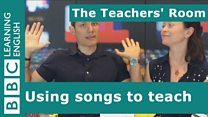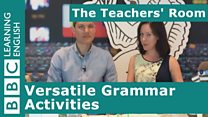Unit 20: English You Need
Exams, news, pronunciation, teachers' tips, learners' questions
Select a unit
- 1 English You Need
- 2 English You Need
- 3 English You Need
- 4 English You Need
- 5 English You Need
- 6 English You Need
- 7 English You Need
- 8 English You Need
- 9 English You Need
- 10 English You Need
- 11 English You Need
- 12 English You Need
- 13 English You Need
- 14 English You Need
- 15 English You Need
- 16 English You Need
- 17 English You Need
- 18 English You Need
- 19 English You Need
- 20 English You Need
- 21 English You Need
- 22 English You Need
- 23 English You Need
- 24 English You Need
- 25 English You Need
- 26 English You Need
- 27 English You Need
- 28 English You Need
- 29 English You Need
- 30 English You Need
Session 4
Welcome to The Teachers’ Room. The show all about teaching practice. Grab a cup of coffee, pull up an armchair and relax. Learn something new, remember something fundamental or just have a giggle.
Activity 1
The Teachers' Room
Teaching models 2
Dan and Sian talk about 3 more teaching models
Watch the video and complete the activity

___________________________________________________________________
Did you like that? Why not try these?
____________________________________________________________________________________
Teaching models
A teaching model is a way of structuring a lesson or introducing a language point. It is useful to have a range of these techniques since a good teacher can account for individual differences in learning style and level of knowledge.
TPR
Total Physical Response is more of a teaching tool than a method per se, but it still has its uses! It involves incorporating physical movements into language learning in order to aid memorisation and consolidation. This can be as simple as teaching the present continuous using mime – John is walking. It works well with movement and action verbs, prepositions of place, tangible noun vocabulary and literal phrasal verbs, but can be adapted to other structures with a little thought. Its novelty often makes it invigorating, original and more memorable.
TBL
Task-based learning focuses on the completion of a ‘real-world’ task rather than focussing on one particular structure. As a result, the language to be studied may not be determined by the teacher, though this depends on the level of the class, and TBL tasks often incorporate a wide range of structures – everything is ok provided it aids completion of the task. Teachers can provide guidance, monitoring and ultimately assessment. Since the task is a real-world simulation, TBL is great for looking at practical language learning and building confidence in students.
PBL
Project based learning is the bigger brother of TBL. Rather than focussing on one smaller task, students are briefed by a teacher as to what they need do. They must then research the project, reporting to the teacher for intermediary guidance and advice, and finally compile some kind of feedback to be assessed by the teacher e.g. a report or a presentation. An example of this would be writing a script for a soap opera. The teacher might provide an example and answer any questions, making sure to set a clear time-scale. Then students could watch several examples of soap operas and pick out the common features before attempting to write their script. Finally, they perform for the class.
To do
Try our quiz to see if you've picked up our tips.
The Teachers' Room Quiz
4 Questions
Check what you've learned by selecting the correct answer to each question.
Help
Activity
Check what you've learned by selecting the correct answer to each question.
Hint
Remember, project based learning involves the completion of a larger task over an extended period of time.Question 1 of 4
Help
Activity
Check what you've learned by selecting the correct answer to each question.
Hint
How often do you use physical movement and actions in class and how do the students react to it?Question 2 of 4
Help
Activity
Check what you've learned by selecting the correct answer to each question.
Hint
Does TBL teach or encourage the use of only one structure or a range of them?Question 3 of 4
Help
Activity
Check what you've learned by selecting the correct answer to each question.
Hint
What kind of tasks do these models feature?Question 4 of 4
Excellent! Great job! Bad luck! You scored:
Get involved
Well, those were just a few ideas that we here at BBC Learning English had, but we know that you teachers out there have lots of fantastic ideas too, and we’d like you to share them with us and everybody else.
If you have a great tip or technique for introducing language, or anything else, please email us at learningenglish@bbc.co.uk. Your email could be posted here on this page, or may even be mentioned in our show.
We are also looking for video tips to include in the programme. In order to do this, please include whether or not you’d like to be included for video with your tip, and we'll get in touch with you. You could be rewarded with a T-shirt for your efforts.
End of Session 4
Next up is Learners' Questions. What will this week's Learner Question be? Whatever it is, Dan's here with the answer! Join us in Session 5 to find out.
Session Vocabulary
Teaching models 2
- TPR: Total Physical Response
- TBL: Task Based Learning
- PBL: Project Based Learning


